
A | B | C | D | E | F | G | H | CH | I | J | K | L | M | N | O | P | Q | R | S | T | U | V | W | X | Y | Z | 0 | 1 | 2 | 3 | 4 | 5 | 6 | 7 | 8 | 9
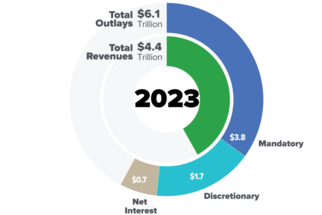
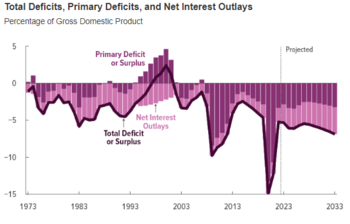
| This article is part of a series on the |
| Budget and debt in the United States of America |
|---|
  |
The United States budget comprises the spending and revenues of the U.S. federal government. The budget is the financial representation of the priorities of the government, reflecting historical debates and competing economic philosophies. The government primarily spends on healthcare, retirement, and defense programs. The non-partisan Congressional Budget Office provides extensive analysis of the budget and its economic effects. CBO estimated in February 2024 that Federal debt held by the public is projected to rise from 99 percent of GDP in 2024 to 116 percent in 2034 and would continue to grow if current laws generally remained unchanged. Over that period, the growth of interest costs and mandatory spending outpaces the growth of revenues and the economy, driving up debt. Those factors persist beyond 2034, pushing federal debt higher still, to 172 percent of GDP in 2054.[1]
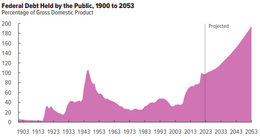
Overview
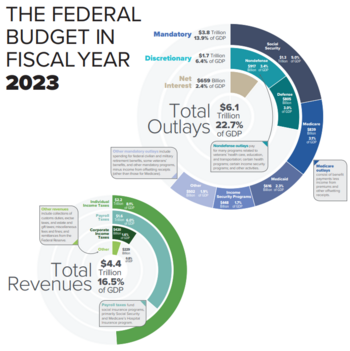
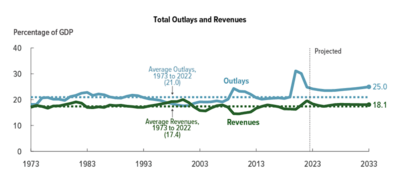

The budget document often begins with the President's proposal to Congress recommending funding levels for the next fiscal year, beginning October 1 and ending on September 30 of the year following. The fiscal year refers to the year in which it ends. However, Congress is the body required by law to pass appropriations annually and to submit funding bills passed by both houses to the President for signature. Congressional decisions are governed by rules and legislation regarding the federal budget process. Budget committees set spending limits for the House and Senate committees and for Appropriations subcommittees, which then approve individual appropriations bills to allocate funding to various federal programs.[2]
If Congress fails to pass an annual budget, then several appropriations bills must be passed as "stop gap" measures. After Congress approves an appropriations bill, it is then sent to the President, who may either sign it into law or veto it. A vetoed bill is sent back to Congress, which can pass it into law with a two-thirds majority in each legislative chamber. Congress may also combine all or some appropriations bills into one omnibus reconciliation bill. In addition, the president may request and the Congress may pass supplemental appropriations bills or emergency supplemental appropriations bills.
Several government agencies provide budget data and analysis. These include the Government Accountability Office (GAO), the Congressional Budget Office (CBO), the Office of Management and Budget (OMB), and the Treasury Department. These agencies have reported that the federal government is facing many important long-run financing challenges, primarily driven by an aging population, rising interest payments, and spending for healthcare programs like Medicare and Medicaid.[3]
During FY2022, the federal government spent $6.3 trillion. Spending as % of GDP is 25.1%, almost 2 percentage points greater than the average over the past 50 years. Major categories of FY 2022 spending included: Medicare and Medicaid ($1,339B or 5.4% of GDP), Social Security ($1.2T or 4.8% of GDP), non-defense discretionary spending used to run federal Departments and Agencies ($910B or 3.6% of GDP), Defense Department ($751B or 3.0% of GDP), and net interest ($475B or 1.9% of GDP).[4]
CBO projects a federal budget deficit of $1.6 trillion for 2024. In the agency’s projections, deficits generally increase over the coming years; the shortfall in 2034 is $2.6 trillion. The deficit amounts to 5.6 percent of gross domestic product (GDP) in 2024, swells to 6.1 percent of GDP in 2025, and then declines in the two years that follow. After 2027, deficits increase again, reaching 6.1 percent of GDP in 2034.[1]
The following table summarizes several budgetary statistics for the fiscal year 2015-2021 periods as a percent of GDP, including federal tax revenue, outlays or spending, deficits (revenue – outlays), and debt held by the public. The historical average for 1969-2018 is also shown. With U.S. GDP of about $21 trillion in 2019, 1% of GDP is about $210 billion.[5] Statistics for 2020-2022 are from the CBO Monthly Budget Review for FY 2022.[6]
| Variable As % GDP | 2015 | 2016 | 2017 | 2018 | 2019 | 2020 | 2021 | 2022 | Hist Avg |
|---|---|---|---|---|---|---|---|---|---|
| Revenue[5] | 18.0% | 17.6% | 17.2% | 16.4% | 16.4% | 16.2% | 17.9% | 19.6% | 17.4% |
| Outlays[5] | 20.4% | 20.8% | 20.6% | 20.2% | 21.0% | 31.1% | 30.1% | 25.1% | 21.0% |
| Budget Deficit[5] | -2.4% | -3.2% | -3.5% | -3.8% | -4.6% | -14.9% | -12.3% | -5.5% | -3.6% |
| Debt Held by Public[5] | 72.5% | 76.4% | 76.2% | 77.6% | 79.4% | 100.3% | 99.6% | 94.7% |
Budget principles
The U.S. Constitution (Article I, section 9, clause 7) states that "No money shall be drawn from the Treasury, but in Consequence of Appropriations made by Law; and a regular Statement and Account of Receipts and Expenditures of all public Money shall be published from time to time."
Each year, the President of the United States submits a budget request to Congress for the following fiscal year as required by the Budget and Accounting Act of 1921. Current law (31 U.S.C. § 1105(a)) requires the president to submit a budget no earlier than the first Monday in January, and no later than the first Monday in February. Typically, presidents submit budgets on the first Monday in February. The budget submission has been delayed, however, in some new presidents' first year when the previous president belonged to a different party.
The federal budget is calculated largely on a cash basis. That is, revenues and outlays are recognized when transactions are made. Therefore, the full long-term costs of programs such as Medicare, Social Security, and the federal portion of Medicaid are not reflected in the federal budget. By contrast, many businesses and some other national governments have adopted forms of accrual accounting, which recognizes obligations and revenues when they are incurred. The costs of some federal credit and loan programs, according to provisions of the Federal Credit Reform Act of 1990, are calculated on a net present value basis.[7]
Federal agencies cannot spend money unless funds are authorized and appropriated. Typically, separate Congressional committees have jurisdiction over authorization and appropriations. The House and Senate Appropriations Committees currently have 12 subcommittees, which are responsible for drafting the 12 regular appropriations bills that determine amounts of discretionary spending for various federal programs. Appropriations bills must pass both the House and Senate and then be signed by the president in order to give federal agencies the legal budget authority to spend.[8] In many recent years, regular appropriations bills have been combined into "omnibus" bills.
Congress may also pass "special" or "emergency" appropriations. Spending that is deemed an "emergency" is exempt from certain Congressional budget enforcement rules. Funds for disaster relief have sometimes come from supplemental appropriations, such as after Hurricane Katrina. In other cases, funds included in emergency supplemental appropriations bills support activities not obviously related to actual emergencies, such as parts of the 2000 Census of Population and Housing. Special appropriations have been used to fund most of the costs of war and occupation in Iraq and Afghanistan so far.[citation needed]
Budget resolutions and appropriations bills, which reflect spending priorities of Congress, will usually differ from funding levels in the president's budget. The president, however, retains substantial influence over the budget process through veto power and through congressional allies when the president's party has a majority in Congress.
Budget authority versus outlays
The amount of budget authority and outlays for a fiscal year usually differ because the government can incur obligations for future years. This means that budget authority from a previous fiscal year can, in many cases, be used for expenditure of funds in future fiscal years; for example, a multi-year contract.
Budget authority is the legal authority provided by federal law to enter into financial obligations that will result in immediate or future outlays involving federal government funds. Outlays refer to the issuance of checks, disbursement of cash or electronic transfer of funds made to liquidate a federal obligation and is usually synonymous with "expenditure" or "spending". The term "appropriations" refers to budget authority to incur obligations and to make payments from the Treasury for specified purposes. Some military and some housing programs have multi-year appropriations, in which their budget authority is specified for several coming fiscal years.
In the congressional budgeting process, an "authorization" (technically the "authorization act") provides the legal authority for the executive branch to act, establishes an account which can receive money to implement the action, and sets a limit on how much money may be expended. However, this account remains empty until Congress approves an "appropriation", which requires the U.S. Treasury to provide funds (up to the limit provided for in the authorization). Congress is not required to appropriate as much money as is authorized.[9]
Congress may both authorize and appropriate in the same bill. Known as "authorization bills", such legislation usually provides for a multi-year authorization and appropriation. Authorization bills are particularly useful when funding entitlement programs (benefits which federal law says an individual has a right to, regardless if any money is appropriated), where estimating the amount of funds to be spent is difficult. Authorization bills are also useful when giving a federal agency the right to borrow money, sign contracts, or provide loan guarantees. In 2007, two-thirds of all federal spending came through authorization bills.[10]
A "backdoor authorization" occurs when an appropriation is made and an agency required to spend the money even when no authorizing legislation has been enacted. A "backdoor appropriation" occurs when authorizing legislation requires an agency to spend a specific amount of money on a specific project within a specific period of time. Because the agency would be violating the law if it did not do so, it is required to spend the money—even if no appropriation has been made. Backdoor appropriations are particularly vexsome because removing the appropriation requires amending federal law, which is often politically impossible to do within a short period of time. Backdoor authorizations and appropriations are sources of significant friction in Congress. Authorization and appropriations committees jealously guard their legislative rights, and the congressional budgeting process can break down when committees overstep their boundaries and are retaliated against.[11]
Federal budget data



Several government agencies provide budget data. These include the Government Accountability Office (GAO), the Congressional Budget Office (CBO), the Office of Management and Budget (OMB) and the U.S. Treasury Department. The CBO publishes The Budget and Economic Outlook in January, which covers a ten-year window and is typically updated in August. It also publishes a Long-Term Budget Outlook in July and a Monthly Budget Review. The OMB, which is responsible for organizing the President's budget presented in February, typically issues a budget update in July. The GAO and the Treasury issue Financial Statements of the U.S. Government, usually in the December following the close of the federal fiscal year, which occurs September 30. There is a corresponding Citizen's Guide, a short summary. The Treasury Department also produces a Combined Statement of Receipts, Outlays, and Balances each December for the preceding fiscal year, which provides detailed data on federal financial activities.
Historical tables within the President's Budget (OMB) provide a wide range of data on federal government finances. Many of the data series begin in 1940 and include estimates of the President's Budget for 2018–2023. Additionally, Table 1.1 provides data on receipts, outlays, and surpluses or deficits for 1901–1939 and for earlier multi-year periods. This document is composed of 17 sections, each of which has one or more tables. Each section covers a common theme. Section 1, for example, provides an overview of the budget and off-budget totals; Section 2 provides tables on receipts by source; and Section 3 shows outlays by function. When a section contains several tables, the general rule is to start with tables showing the broadest overview data and then work down to more detailed tables. The purpose of these tables is to present a broad range of historical budgetary data in one convenient reference source and to provide relevant comparisons likely to be most useful. The most common comparisons are in terms of proportions (e.g., each major receipt category as a percentage of total receipts and of the gross domestic product).[13]
Federal budget projections
The Congressional Budget Office (CBO) projects budget data such as revenues, expenses, deficits, and debt as part of its "Long-term Budget Outlook" which is released annually. The 2018 Outlook included projections for debt through 2048 and beyond. CBO outlined several scenarios that result in a range of outcomes. The "Extended Baseline" scenario and "Extended Alternative Fiscal" scenario both result in a much higher level of debt relative to the size of the economy (GDP) as the country ages and healthcare costs rise faster than the rate of economic growth. CBO also identified scenarios involving significant austerity measures, which maintain or reduce the debt relative to GDP over time.
CBO estimated the size of changes that would be needed to achieve a chosen goal for federal debt. For example, if lawmakers wanted to reduce the amount of debt in 2048 to 41 percent of GDP (its average over the past 50 years), they might cut non-interest spending, increase revenues, or take a combination of both approaches to make changes that equaled 3.0 percent of GDP each year starting in 2019. (In dollar terms, that amount would total about $630 billion in 2019.) If, instead, policymakers wanted debt in 2048 to equal its current share of GDP (78 percent), the necessary changes would be smaller (although still substantial), totaling 1.9 percent of GDP per year (or about $400 billion in 2019). The longer lawmakers waited to act, the larger the policy changes would need to be to reach any particular goal for federal debt.[14]
Major receipt categories

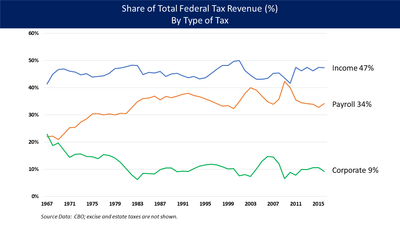

During FY2018, the federal government collected approximately $3.33 trillion in tax revenue, up $14 billion or less than 1% versus FY2017. Primary receipt categories included individual income taxes ($1,684B or 51% of total receipts), Social Security/Social Insurance taxes ($1,171B or 35%), and corporate taxes ($205B or 6%). Corporate tax revenues declined by $92 billion or 32% due to the Tax Cuts and Jobs Act. Other revenue types included excise, estate and gift taxes. FY 2018 revenues were 16.4% of gross domestic product (GDP), versus 17.2% in FY 2017.[16] Tax revenues averaged approximately 17.4% GDP over the 1980-2017 period.[17]
During FY2017, the federal government collected approximately $3.32 trillion in tax revenue, up $48 billion or 1.5% versus FY2016. Primary receipt categories included individual income taxes ($1,587B or 48% of total receipts), Social Security/Social Insurance taxes ($1,162B or 35%), and corporate taxes ($297B or 9%). Other revenue types included excise, estate and gift taxes. FY 2017 revenues were 17.3% of gross domestic product (GDP), versus 17.7% in FY 2016. Tax revenues averaged approximately 17.4% GDP over the 1980-2017 period.[17]
Tax revenues are significantly affected by the economy. Recessions typically reduce government tax collections as economic activity slows. For example, tax revenues declined from $2.5 trillion in 2008 to $2.1 trillion in 2009, and remained at that level in 2010. From 2008 to 2009, individual income taxes declined 20%, while corporate taxes declined 50%. At 14.6% of GDP, the 2009 and 2010 collections were the lowest level of the past 50 years.[18]
Tax policy
Tax descriptions
The federal personal income tax is progressive, meaning a higher marginal tax rate is applied to higher ranges of income. For example, in 2010 the tax rate that applied to the first $17,000 in taxable income for a couple filing jointly was 10%, while the rate applied to income over $379,150 was 35%. The top marginal tax rate has declined considerably since 1980. For example, the top tax rate was lowered from 70% to 50% in 1980 and reached as low as 28% in 1988. The Bush tax cuts of 2001 and 2003, extended by President Obama in 2010, lowered the top rate from 39.6% to 35%.[19] The American Taxpayer Relief Act of 2012 raised the income tax rates for individuals earning over $400,000 and couples over $450,000. There are numerous exemptions and deductions, that typically result in a range of 35–40% of U.S. households owing no federal income tax. The recession and tax cut stimulus measures increased this to 51% for 2009, versus 38% in 2007.[20] In 2011 it was found that 46% of households paid no federal income tax, however the top 1% contributed about 25% of total taxes collected.[21] In 2014, the top 1% paid approximately 46% of the federal income taxes, excluding payroll taxes.[22]
The federal payroll tax (FICA) partially funds Social Security and Medicare. For the Social Security portion, employers and employees each pay 6.2% of the workers gross pay, a total of 12.4%. The Social Security portion is capped at $118,500 for 2015, meaning income above this amount is not subject to the tax. It is a flat tax up to the cap, but regressive overall as it is not applied to higher incomes. The Medicare portion is also paid by employer and employee each at 1.45% and is not capped. Starting in 2013, an additional 0.9 percent more in Medicare taxes was applied to income of more than $200,000 ($250,000 for married couples filing jointly), making it a progressive tax overall.
For calendar years 2011 and 2012, the employee's portion of the payroll tax was reduced to 4.2% as an economic stimulus measure; this expired for 2013.[23] Approximately 65% percent of tax return filers pay more in payroll taxes than income taxes.[24]
Tax expenditures
The term "tax expenditures" refers to income exclusions, deductions, preferential rates, and credits that reduce revenues for any given level of tax rates in the individual, payroll, and corporate income tax systems. Like conventional spending, they contribute to the federal budget deficit. They also influence choices about working, saving, and investing, and affect the distribution of income. The amount of reduced federal revenues are significant, estimated by CBO at nearly 8% GDP or about $1.5 trillion in 2017, for scale roughly half the revenue collected by the government and nearly three times as large as the budget deficit. Since eliminating a tax expenditure changes economic behavior, the amount of additional revenue that would be generated is somewhat less than the estimated size of the tax expenditure.[18]
CBO reported that the following were among the largest individual (non-corporate) tax expenditures in 2013:
- $248B – The exclusion from workers’ taxable income of employers’ contributions for health care, health insurance premiums, and premiums for long-term care insurance;
- $137B – The exclusion of contributions to and the earnings of pension funds such as 401k plans;
- $161B – Preferential tax rates on dividends and long-term capital gains;
- $77B – The deductions for state and local taxes;
- $70B – The deductions for mortgage interest.
In 2013, CBO estimated that more than half of the combined benefits of 10 major tax expenditures would apply to households in the top 20% income group, and that 17% of the benefit would go to the top 1% households. The top 20% of income earners pay about 70% of federal income taxes, excluding payroll taxes.[25] For scale, 50% of the $1.5 trillion in tax expenditures in 2016 was $750 billion, while the U.S. budget deficit was approximately $600 billion.[18] In other words, eliminating the tax expenditures for the top 20% might balance the budget over the short-term, depending on economic feedback effects.
Major expenditure categories
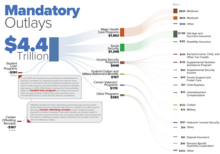

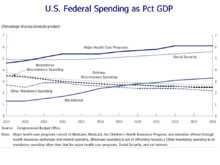

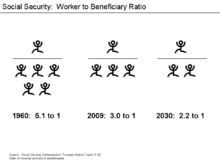
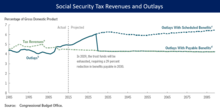
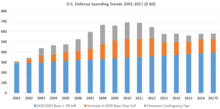

During FY2018, the federal government spent $4.11 trillion, up $127 billion or 3.2% vs. FY2017 spending of $3.99 trillion. Spending increased for all major categories and was mainly driven by higher spending for Social Security, net interest on the debt, and defense. Spending as % GDP fell from 20.7% GDP to 20.3% GDP, equal to the 50-year average.[16]
During FY2017, the federal government spent $3.98 trillion, up $128 billion or 3.3% vs. FY2016 spending of $3.85 trillion. Major categories of FY 2017 spending included: Healthcare such as Medicare and Medicaid ($1,077B or 27% of spending), Social Security ($939B or 24%), non-defense discretionary spending used to run federal Departments and Agencies ($610B or 15%), Defense Department ($590B or 15%), and interest ($263B or 7%).[17]
Expenditures are classified as "mandatory", with payments required by specific laws to those meeting eligibility criteria (e.g., Social Security and Medicare), or "discretionary", with payment amounts renewed annually as part of the budget process. Around two thirds of federal spending is for "mandatory" programs. CBO projects that mandatory program spending and interest costs will rise relative to GDP over the 2016–2026 period, while defense and other discretionary spending will decline relative to GDP.[18]
Mandatory spending and social safety nets
Social Security, Medicare, and Medicaid expenditures are funded by more permanent Congressional appropriations and so are considered mandatory spending.[27] Social Security and Medicare are sometimes called "entitlements", because people meeting relevant eligibility requirements are legally entitled to benefits; most pay taxes into these programs throughout their working lives. Some programs, such as Food Stamps, are appropriated entitlements. Some mandatory spending, such as Congressional salaries, is not part of any entitlement program. Mandatory spending accounted for 59.8% of total federal outlays (net of receipts that partially pay for the programs), with net interest payments accounting for an additional 6.5%. In 2000, these were 53.2% and 12.5%, respectively.[18]
Mandatory spending is expected to continue increasing as a share of GDP. This is due in part to demographic trends, as the number of workers continues declining relative to those receiving benefits. For example, the number of workers per retiree was 5.1 in 1960; this declined to 3.0 in 2010 and is projected to decline to 2.2 by 2030.[28][29] These programs are also affected by per-person costs, which are also expected to increase at a rate significantly higher than economic growth. This unfavorable combination of demographics and per-capita rate increases is expected to drive both Social Security and Medicare into large deficits during the 21st century. Unless these long-term fiscal imbalances are addressed by reforms to these programs, raising taxes or drastic cuts in discretionary programs, the federal government will at some point be unable to pay its obligations without significant risk to the value of the dollar (inflation).[30][31] By one estimate, 70% of the growth in these entitlement expenses over the 2016-2046 period is due to healthcare.[32]
- Medicare was established in 1965 and expanded thereafter. Spending for Medicare during 2016 was $692 billion, versus $634 billion in 2014, an increase of $58 billion or 9%.[18] In 2013, the program covered an estimated 52.3 million persons. It consists of four distinct parts which are funded differently: Hospital Insurance, mainly funded by a dedicated payroll tax of 2.9% of earnings, shared equally between employers and workers; Supplementary Medical Insurance, funded through beneficiary premiums (set at 25% of estimated program costs for the aged) and general revenues (the remaining amount, approximately 75%); Medicare Advantage, a private plan option for beneficiaries, funded through the Hospital Insurance and Supplementary Medical Insurance trust funds; and the Part D prescription drug benefits, for which funding is included in the Supplementary Medical Insurance trust fund and is financed through beneficiary premiums (about 25%) and general revenues (about 75%).[33] Spending on Medicare and Medicaid is projected to grow dramatically in coming decades. The number of persons enrolled in Medicare is expected to increase from 47 million in 2010 to 80 million by 2030.[34] While the same demographic trends that affect Social Security also affect Medicare, rapidly rising medical prices appear to be a more important cause of projected spending increases. CBO expects Medicare and Medicaid to continue growing, rising from 5.3% GDP in 2009 to 10.0% in 2035 and 19.0% by 2082. CBO has indicated healthcare spending per beneficiary is the primary long-term fiscal challenge.[35] Various reform strategies were proposed for healthcare,[36] and in March 2010, the Patient Protection and Affordable Care Act was enacted as a means of health care reform. CBO reduced its per capita Medicare spending assumptions by $1,000 for 2014 and $2,300 for 2019, relative to its 2010 estimate for those years.[37] If this trend continues, it will significantly improve the long-term budget outlook.[38]
- Social Security is a social insurance program officially called "Old-Age, Survivors, and Disability Insurance" (OASDI), in reference to its three components. It is primarily funded through a dedicated payroll tax of 12.4%. During 2016, total benefits of $910 billion were paid out, versus $882 billion in 2015, an increase of $28 billion or 3%.[18] Social Security's total expenditures have exceeded its non-interest income since 2010. The deficit of non-interest income relative to cost was about $49 billion in 2010, $45 billion in 2011, and $55 billion in 2012.[39] During 2010, an estimated 157 million people paid into the program and 54 million received benefits, roughly 2.91 workers per beneficiary.[40] Since the Greenspan Commission in the early 1980s, Social Security has cumulatively collected far more in payroll taxes dedicated to the program than it has paid out to recipients—nearly $2.6 trillion in 2010. This annual surplus is credited to Social Security trust funds that hold special non-marketable Treasury securities. This surplus amount is commonly referred to as the "Social Security Trust Fund." The proceeds are paid into the U.S. Treasury where they may be used for other government purposes. Social Security spending will increase sharply over the next decades, largely due to the retirement of the baby boom generation. The number of program recipients is expected to increase from 44 million in 2010 to 73 million in 2030.[34] Program spending is projected to rise from 4.8% of GDP in 2010 to 5.9% of GDP by 2030, where it will stabilize.[41] The Social Security Administration projects that an increase in payroll taxes equivalent to 1.8% of the payroll tax base or 0.6% of GDP would be necessary to put the Social Security program in fiscal balance for the next 75 years. Over an infinite time horizon, these shortfalls average 3.3% of the payroll tax base and 1.2% of GDP.[42] Various reforms have been debated for Social Security. Examples include reducing future annual cost of living adjustments (COLA) provided to recipients, raising the retirement age, and raising the income limit subject to the payroll tax ($118,500 in 2014).[43][44] Because of the mandatory nature of the program and large accumulated surplus in the Social Security Trust Fund, the Social Security system has the legal authority to compel the government to borrow to pay all promised benefits through 2036, when the Trust Fund is expected to be exhausted. Thereafter, the program under current law will pay approximately 75–78% of promised benefits for the remainder of the century.[40][45]
Discretionary spending

- Military spending: During 2016, the Department of Defense spent $585 billion, an increase of $1 billion versus 2015. This is a partial measure of all defense-related spending. The military budget of the United States during FY 2014 was approximately $582 billion in expenses for the Department of Defense (DoD), $149 billion for the Department of Veterans Affairs, and $43 billion for the Department of Homeland Security, for a total of $770 billion. This was approximately $33 billion or 4.1% below 2013 spending. DoD spending has fallen from a peak of $678 billion in 2011.[46] The U.S. defense budget (excluding spending for the wars in Iraq and Afghanistan, Homeland Security, and Veteran's Affairs) is around 4% of GDP. Adding these other costs places defense spending around 5% GDP. The DoD baseline budget, excluding supplemental funding for the wars, grew from $297 billion in FY2001 to a budgeted $534 billion for FY2010, an 81% increase.[47] According to the CBO, defense spending grew 9% annually on average from fiscal years 2000–2009.[48] Much of the costs for the wars in Iraq and Afghanistan have not been funded through regular appropriations bills, but through emergency supplemental appropriations bills. As such, most of these expenses were not included in the military budget calculation prior to FY2010. Some budget experts argue that emergency supplemental appropriations bills do not receive the same level of legislative care as regular appropriations bills.[49] During 2011, the U.S. spent more on its military budget than the next 13 countries combined.[50]
- Non-defense discretionary spending is used to fund the executive departments (e.g., the Department of Education) and independent agencies (e.g., the Environmental Protection Agency), although these do receive a smaller amount of mandatory funding as well. Discretionary budget authority is established annually by Congress, as opposed to mandatory spending that is required by laws that span multiple years, such as Social Security or Medicare. The federal government spent approximately $600 billion during 2016 on the Cabinet Departments and Agencies, excluding the Department of Defense, up $15 billion or 3% versus 2015. This represented 16% of budgeted expenditures or about 3.3% of GDP. Spending is below the recent dollar peak of $658 billion in 2010.[51]
Interest expense
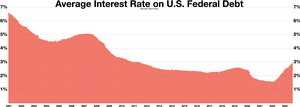

CBO reported that net interest on the public debt was approximately $240 billion in FY2016 (6% of spending), an increase of $17 billion or 8% versus FY2015. A higher level of debt coincided with higher interest rates.[18] During FY2012, the GAO reported a figure of $245 billion, down from $251 billion. Government also accrued a non-cash interest expense of $187 billion for intragovernmental debt, primarily the Social Security Trust Fund, for a total interest expense of $432 billion. GAO reported that even though the national debt rose in FY2012, the interest rate paid declined.[52] Should interest rates rise to historical averages, the interest cost would increase dramatically.
As of January 2012, public debt owned by foreigners has increased to approximately 50% of the total or approximately $5.0 trillion.[53] As a result, nearly 50% of the interest payments are now leaving the country, which is different from past years when interest was paid to U.S. citizens holding the public debt. Interest expenses are projected to grow dramatically as the U.S. debt increases and interest rates rise from very low levels to more typical historical levels.[18]
Deficits and debt

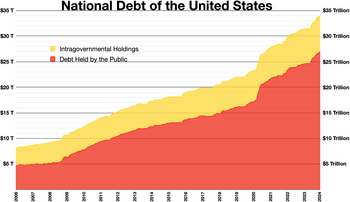
Relationship of deficit and debt
Intuitively, the annual budget deficit should represent the amount added to the national debt.[54] However, there are certain types of spending ("supplemental appropriations") outside the budget process which are not captured in the deficit computation, which also add to the national debt. Prior to 2009, spending for the wars in Iraq and Afghanistan was often funded through special appropriations excluded from the budget deficit calculation. In FY2010 and prior, the budget deficit and annual change in the national debt were significantly different. For example, the U.S. added $1 trillion to the national debt in FY2008 but reported a deficit of $455 billion. Due to rules changes implemented under President Obama in 2009, the two figures have moved closer together and were nearly identical in 2013 (a CBO-reported deficit of $680 billion versus change in debt of $672 billion). For FY2014, the difference widened again, with the CBO reporting a deficit of $483 billion [55] compared to a change in total debt outstanding of $1,086 billion.[56]
Debt categories
The total federal debt is divided into "debt held by the public" and "intra-governmental debt." The debt held by the public refers to U.S. government securities or other obligations held by investors (e.g., bonds, bills, and notes), while Social Security and other federal trust funds are part of the intra-governmental debt. As of September 30, 2012, the total debt was $16.1 trillion, with debt held by the public of $11.3 trillion and intragovernmental debt of $4.8 trillion.[57] Debt held by the public as a percentage of gross domestic product (GDP) rose from 34.7% in 2000 to 40.3% in 2008 and 70.0% in 2012.[58] U.S. GDP was approximately $15 trillion during 2011 and an estimated $15.6 trillion for 2012 based on activity during the first two quarters.[59] This means the total debt is roughly the size of GDP. Economists debate the level of debt relative to GDP that signals a "red line" or dangerous level, or if any such level exists.[60] By comparison, China's budget deficit was 1.6% of its $10 trillion GDP in 2010, with a debt to GDP ratio of 16%.[61]
Risks associated with the debt
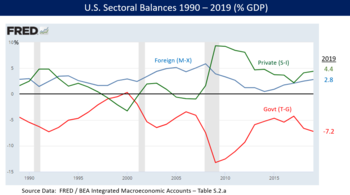
The CBO reported several types of risk factors related to rising debt levels in a July 2010 publication:
- A growing portion of savings would go towards purchases of government debt, rather than investments in productive capital goods such as factories and leading to lower output and incomes than would otherwise occur;
- Rising interest costs would force reductions in important government programs;
- To the extent that additional tax revenues were generated by increasing marginal tax rates, those rates would discourage work and saving, further reducing output and incomes;
- Restrictions to the ability of policymakers to use fiscal policy to respond to economic challenges; and
- An increased risk of a sudden fiscal pressure on the government, in which investors demand higher interest rates.[62]
However, since mid- to late-2010, the U.S. Treasury has been obtaining negative real interest rates at Treasury security auctions. At such low rates, government debt borrowing saves taxpayer money according to one economist.[63] There is no guarantee that such rates will continue, but the trend has remained falling or flat as of October 2012.[64]
Fears of a fiscal crisis triggered by a significant selloff of U.S. Treasury securities by foreign owners such as China and Japan did not materialize, even in the face of significant sales of those securities during 2015, as demand for U.S. securities remained robust.[65]
Government budget balance as a sectoral component
Economist Martin Wolf explained in July 2012 that government fiscal balance is one of three major financial sectoral balances in the U.S. economy, the others being the foreign financial sector and the private financial sector. The sum of the surpluses or deficits across these three sectors must be zero by definition. Since the foreign and private sectors are in surplus, the government sector must be in deficit.
Wolf argued that the sudden shift in the private sector from deficit to surplus due to the global economic conditions forced the government balance into deficit, writing: "The financial balance of the private sector shifted towards surplus by the almost unbelievable cumulative total of 11.2 percent of gross domestic product between the third quarter of 2007 and the second quarter of 2009, which was when the financial deficit of US government (federal and state) reached its peak...No fiscal policy changes explain the collapse into massive fiscal deficit between 2007 and 2009, because there was none of any importance. The collapse is explained by the massive shift of the private sector from financial deficit into surplus or, in other words, from boom to bust."[66]
Economist Paul Krugman also explained in December 2011 the causes of the sizable shift from private sector deficit to surplus: "This huge move into surplus reflects the end of the housing bubble, a sharp rise in household saving, and a slump in business investment due to lack of customers."[67]
Contemporary issues and debates
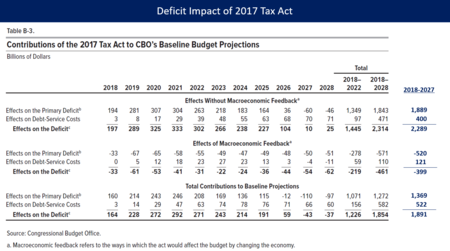

Conceptual arguments
Many of the debates surrounding the United States federal budget center around competing macroeconomic schools of thought. In general, Democrats favor the principles of Keynesian economics to encourage economic growth via a mixed economy of both private and public enterprise, a welfare state, and strong regulatory oversight. Conversely, Republicans and Libertarians generally support applying the principles of either laissez-faire or supply-side economics to grow the economy via small government, low taxes, limited regulation, and free enterprise.[69][70] Debates have surrounded the appropriate size and role of the federal government since the founding of the country. These debates also deal with questions of morality, income equality, and intergenerational equity. For example, Congress adding to the debt today may or may not enhance the quality of life for future generations, who must also bear the additional interest and taxation burden.[71]
Political realities make major budgetary deals difficult to achieve. While Republicans argue conceptually for reductions in Medicare and Social Security, they are hesitant to actually vote to reduce the benefits from these popular programs. Democrats on the other hand argue conceptually for tax increases on the wealthy, yet may be hesitant to vote for them because of the effect on campaign donations from the wealthy. The so-called budgetary "grand bargain" of tax hikes on the rich and removal of some popular tax deductions in exchange for reductions to Medicare and Social Security is therefore elusive.[72]
Trump tax cuts
President Trump signed the Tax Cuts and Jobs Act into law in December 2017. CBO forecasts that the 2017 Tax Act will increase the sum of budget deficits (debt) by $2.289 trillion over the 2018-2027 decade, or $1.891 trillion after macro-economic feedback. This is in addition to the $10.1 trillion increase forecast under the June 2017 policy baseline and existing $20 trillion national debt.[17] The Tax Act will reduce spending for lower income households while cutting taxes for higher income households, as CBO reported on December 21, 2017: "Overall, the combined effect of the change in net federal revenue and spending is to decrease deficits (primarily stemming from reductions in spending) allocated to lower-income tax filing units and to increase deficits (primarily stemming from reductions in taxes) allocated to higher-income tax filing units."[73]
CBO forecast in January 2017 (just prior to Trump's inauguration) that revenues in fiscal year 2018 would be $3.60 trillion if laws in place as of January 2017 continued.[74] However, actual 2018 revenues were $3.33 trillion, a shortfall of $270 billion (7.5%) relative to the forecast. This difference is primarily due to the Tax Act.[75] In other words, revenues would have been considerably higher in the absence of the tax cuts.
The New York Times reported in August 2019 that: "The increasing levels of red ink stem from a steep falloff in federal revenue after Mr. Trump's 2017 tax cuts, which lowered individual and corporate tax rates, resulting in far fewer tax dollars flowing to the Treasury Department. Tax revenues for 2018 and 2019 have fallen more than $430 billion short of what the budget office predicted they would be in June 2017, before the tax law was approved that December."[76]
Healthcare reform
The CBO has consistently reported since 2010 that the Patient Protection and Affordable Care Act (also known as "Obamacare") would reduce the deficit, as its tax increases and reductions in future Medicare spending offset its incremental spending for subsidies for low-income households. The CBO reported in June 2015 that repeal of the ACA would increase the deficit between $137 billion and $353 billion over the 2016–2025 period in total, depending on the impact of macroeconomic feedback effects. In other words, ACA is a deficit reducer, as its repeal would raise the deficit.[77]
The Medicare Trustees provide an annual report of the program's finances. The forecasts from 2009 and 2015 differ materially, mainly due to changes in the projected rate of healthcare cost increases, which have moderated considerably. Rather than rising to nearly 12% GDP over the forecast period (through 2080) as forecast in 2009, the 2015 forecast has Medicare costs rising to 6% GDP, comparable to the Social Security program.[78]
Zdroj:https://en.wikipedia.org?pojem=United_States_federal_budget
Text je dostupný za podmienok Creative Commons Attribution/Share-Alike License 3.0 Unported; prípadne za ďalších podmienok. Podrobnejšie informácie nájdete na stránke Podmienky použitia.
Antropológia
Aplikované vedy
Bibliometria
Dejiny vedy
Encyklopédie
Filozofia vedy
Forenzné vedy
Humanitné vedy
Knižničná veda
Kryogenika
Kryptológia
Kulturológia
Literárna veda
Medzidisciplinárne oblasti
Metódy kvantitatívnej analýzy
Metavedy
Metodika
Text je dostupný za podmienok Creative
Commons Attribution/Share-Alike License 3.0 Unported; prípadne za ďalších
podmienok.
Podrobnejšie informácie nájdete na stránke Podmienky
použitia.
www.astronomia.sk | www.biologia.sk | www.botanika.sk | www.dejiny.sk | www.economy.sk | www.elektrotechnika.sk | www.estetika.sk | www.farmakologia.sk | www.filozofia.sk | Fyzika | www.futurologia.sk | www.genetika.sk | www.chemia.sk | www.lingvistika.sk | www.politologia.sk | www.psychologia.sk | www.sexuologia.sk | www.sociologia.sk | www.veda.sk I www.zoologia.sk
